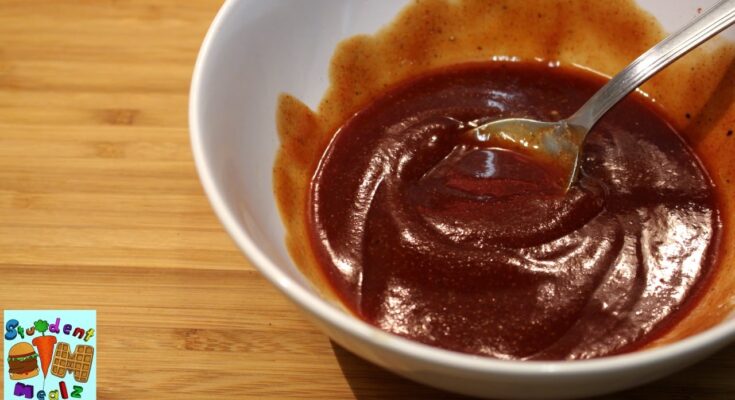Barbeque Sauce Recipe: Nothing elevates a grilled meal quite like the rich, tangy, and slightly smoky taste of barbeque sauce. Whether you’re marinating ribs, glazing chicken, or just looking for the perfect dip for your fries, a good BBQ sauce can make all the difference. And guess what? You don’t need a fancy kitchen or chef skills to whip up a delicious, homemade batch right in your own kitchen. This guide breaks it all down for you, step by step.
What Makes Barbeque Sauce Special?
Barbeque sauce isn’t just a condiment—it’s an experience. The moment it hits your tongue, you’re hit with a unique blend of sweetness, tang, heat, and depth that’s hard to replicate with any other sauce. It has roots in Southern American cuisine but has since become a worldwide favorite. The beauty of barbeque sauce is in its balance. You get that smoky undertone, a pop of vinegar tang, and a rich sweetness that clings to grilled meats like a charm.
BBQ sauce brings people together—family picnics, backyard cookouts, or even solo nights with wings and Netflix. It’s more than just food; it’s part of a culture that celebrates flavor, creativity, and community. Every region has its twist—Kansas City loves it thick and sweet, North Carolina goes heavy on the vinegar, and Texas likes a bold, smoky punch.
Versatility of BBQ Sauce in Cooking
Think barbeque sauce is just for ribs? Think again. This multi-tasking miracle sauce has a place in so many dishes:
- Marinade: Let meats soak in its flavor before they hit the grill.
- Glaze: Brush it on during the last few minutes of cooking for that sticky, caramelized crust.
- Dipping Sauce: Use it for fries, nuggets, onion rings, or even pizza crusts.
- Pizza Base: Swap out the usual marinara for a BBQ base on chicken or pulled pork pizzas.
- Burger Booster: Slather it on burgers for a sweet and smoky kick.
Once you’ve mastered the basic recipe, you’ll never reach for a store-bought bottle again.
Essential Ingredients for Homemade BBQ Sauce
Base Ingredients You Can’t Skip
The foundation of any great BBQ sauce is its base, and here’s what you’ll definitely need:
- Ketchup: This gives the sauce its signature red color and a tomatoey backbone. It’s sweet, tangy, and easy to blend.
- Vinegar: White vinegar or apple cider vinegar brings the essential tang that cuts through the sweetness.
- Brown Sugar: This adds a deep, molasses-like sweetness and helps with caramelization.
- Worcestershire Sauce: Brings umami and depth of flavor—like the secret sauce of your sauce.
- Garlic and Onion Powder: For that savory, aromatic kick.
Without these core ingredients, you’re just making a red sauce—not a true BBQ sauce.
Optional Add-ons for Extra Flavor
If you like to experiment, the sky’s the limit. Here are some bonus ingredients you can toss in to personalize your sauce:
- Smoked Paprika or Liquid Smoke: Adds that campfire char flavor, essential for stovetop versions.
- Hot Sauce or Cayenne Pepper: Turn up the heat with just a few drops.
- Honey or Molasses: Want it richer or stickier? These add both texture and sweetness.
- Mustard: Yellow or Dijon for tang and depth.
- Soy Sauce: A surprising addition that gives saltiness and umami, especially for Asian-inspired dishes.
- Fruit Juices: Pineapple or orange juice can add a bright twist.
With these, your BBQ sauce becomes more than just a recipe—it becomes your signature.
Step-by-Step Guide to Making BBQ Sauce
Step 1 – Gathering Your Ingredients
Before you fire up the stove, make sure you’ve got everything ready. Here’s a basic shopping list for about 2 cups of BBQ sauce:
- 1 cup ketchup
- 1/2 cup apple cider vinegar
- 1/3 cup brown sugar
- 2 tablespoons honey or molasses
- 1 tablespoon Worcestershire sauce
- 1 teaspoon smoked paprika
- 1/2 teaspoon garlic powder
- 1/2 teaspoon onion powder
- 1/4 teaspoon cayenne pepper (optional)
- Salt and black pepper to taste
It’s best to have all your ingredients pre-measured. Trust me, once you start cooking, you won’t want to scramble for the paprika.
Step 2 – Mixing the Base
Start by adding your ketchup, vinegar, and brown sugar to a medium saucepan. Stir them together over medium heat. As the mixture starts to warm, the sugar will dissolve, and everything will blend into a smooth, red base.
This is where the transformation begins. Already, you’ll smell that tangy tomato scent filling the kitchen—don’t be surprised if your stomach starts to rumble.
You’re building the foundation now, so make sure everything is well mixed before you move to the next step. This base is your canvas.
Step 3 – Adding Sweetness and Tang
Once your base is smooth and warm, it’s time to build the bold, rich flavor that BBQ sauce is known for. This is where the real magic happens—balancing sweet and tangy notes to give your sauce depth.
Add your honey or molasses slowly, stirring constantly. Molasses will give your sauce that deep, almost smoky sweetness, while honey lends a brighter, floral profile. Either works well—just make sure not to overdo it. Too much and your sauce might end up tasting like dessert.
Next comes Worcestershire sauce. It may not seem like much, but this is your umami powerhouse. It rounds out the flavor, adds saltiness, and makes the sauce taste like it’s been simmering for hours, even if it hasn’t.
Now’s also the perfect time to taste. Take a spoonful—careful, it’s hot! What’s missing? Need a little more sugar? A splash more vinegar? This is the step where you play chef and tweak the flavor to your liking. Remember, the perfect BBQ sauce hits a balance: it’s not just sweet or just sour—it dances on your tongue with both.
Step 4 – Spice It Up!
Now we bring the fire. If you love a bit of heat in your BBQ, this is the step for you.
Add your garlic powder, onion powder, smoked paprika, and cayenne pepper to the simmering sauce. These aren’t just for flavor—they add warmth, complexity, and that irresistible BBQ aroma. Stir well to make sure the spices are evenly distributed throughout the sauce.
If you like it extra hot, feel free to add a splash of your favorite hot sauce. Start small—like a teaspoon—and build from there. You can always add more, but you can’t take it out.
Want your BBQ sauce to be a little smoky, even without using a grill? This is the time to add liquid smoke. Just a dash goes a long way, so add a few drops, stir, and taste again. This gives your homemade sauce that “fresh-off-the-grill” flavor, even if it’s never touched a flame.
Pro tip: let your sauce sit for a minute after spicing it. Flavors need a moment to marry and mellow. Then taste again before moving to the next step.
Step 5 – Simmer and Stir
This part is all about patience—and trust me, it’s worth it.
Lower the heat to a gentle simmer and let the sauce bubble softly. You’re not trying to boil it into oblivion—just let it reduce slightly so it thickens up. This step usually takes about 15–20 minutes.
Stir occasionally to prevent the sauce from sticking to the bottom of the pan. As it cooks, you’ll notice it turning a deeper shade of red and getting that glossy, sticky finish that clings perfectly to ribs, wings, and burgers.
This slow cooking step is where all those spices and ingredients really blend together into a unified flavor bomb. The heat softens the tang of the vinegar, smooths out the sweetness, and lets that smoky depth shine.
Once it’s thick enough to coat the back of a spoon, your sauce is done. If you like it thinner, you can add a splash of water or vinegar. If you want it thicker, just let it simmer a few more minutes.
Tips for the Perfect BBQ Sauce
Even the best recipes can use a few pro tips. Here’s how to make sure your BBQ sauce isn’t just good—it’s next-level amazing.
Balancing Flavors
Taste is everything with BBQ sauce. If it’s too sweet, add more vinegar. Too sour? Add a spoonful of brown sugar or honey. Not smoky enough? A dash of liquid smoke will fix that.
Use your tongue like a chef’s tool—every tweak makes it better. Write down your changes if you’re experimenting, so when you hit that perfect combo, you can make it again!
Some prefer more tang (Carolina-style), while others want it sticky-sweet (Kansas City-style). There’s no wrong version—just the one you like best.
Adjusting Thickness
Some folks like a thin sauce that drips easily over pulled pork, while others want a thick glaze that sticks to ribs. Here’s how to control it:
- Thinner sauce? Add a little water or vinegar, one tablespoon at a time.
- Thicker sauce? Keep simmering until it reduces.
- Sticky sauce? Add a bit more honey or molasses and cook for a few minutes longer.
Consistency can change based on your ingredients and cooking time, so adjust it to suit your recipe or personal taste.
Storing and Preserving Your BBQ Sauce
Best Practices for Storage
Now that you’ve got a pot of delicious, homemade BBQ sauce, it’s time to store it the right way. Proper storage not only extends shelf life but also helps preserve the rich flavors you’ve worked so hard to develop.
First things first—let your sauce cool completely before storing it. Pouring hot sauce into a container, especially a plastic one, can lead to condensation and unwanted bacteria growth. Let it sit at room temperature until it’s no longer warm to the touch.
Use a clean, airtight container. Glass jars with tight-sealing lids work best because they don’t absorb flavors or smells. If you don’t have a jar, a BPA-free plastic container with a tight lid will do the job.
Label your container with the date you made the sauce. Trust me, it’s easy to lose track once it’s in the fridge. Homemade BBQ sauce will typically last 2 to 3 weeks when stored in the refrigerator. Be sure to keep it at a consistent cold temperature and never double-dip with a used spoon—it’ll introduce bacteria.
Need to store it longer? Keep reading…
Shelf Life and Safety Tips
Here’s how to make your homemade BBQ sauce last even longer without sacrificing flavor or safety:
- Refrigerated: Properly stored, your BBQ sauce will stay fresh in the fridge for up to 3 weeks. Always use clean utensils when scooping some out—no cross-contamination!
- Frozen: Yep, you can freeze BBQ sauce. Just pour it into a freezer-safe container or zip-top bag, leave a little space for expansion, and freeze for up to 3 months. Thaw overnight in the fridge and stir well before using.
- Canning: If you’re into long-term storage and want to preserve your sauce for months, consider water bath canning. This method involves sterilizing jars and sealing them airtight—great for gifting or storing in your pantry. Just be sure your recipe is high-acid (with enough vinegar) for safe canning.
- Smell Test: When in doubt, give it a sniff. If it smells off or funky, it’s time to toss it. Homemade sauces don’t have preservatives, so err on the side of caution.
Remember: safe food handling = safe BBQ sauce = happy bellies.
FAQs about Barbecue Sauce Recipe
1. What are the main ingredients in homemade barbecue sauce?
The basics include ketchup or tomato paste, vinegar, brown sugar, honey or molasses, and a blend of spices like garlic powder, onion powder, and smoked paprika.
2. Can I make barbecue sauce without sugar?
Yes! Use natural sweeteners like honey, maple syrup, or even mashed dates. You can also skip sweeteners entirely for a more tangy, savory flavor.
3. How long does homemade BBQ sauce last?
Stored in an airtight container in the refrigerator, it can last up to 2 weeks. For longer shelf life, freeze it in small batches.
4. Is barbecue sauce gluten-free?
Most homemade recipes are gluten-free, but always check labels on ingredients like soy sauce or Worcestershire sauce to ensure they are gluten-free.
5. Can I adjust the spiciness of the sauce?
Absolutely! Add more chili powder, hot sauce, or cayenne for heat, or reduce them for a milder version.
6. What’s the best vinegar to use?
Apple cider vinegar is the most popular for its tangy-sweet flavor, but white vinegar or balsamic can be used for different taste profiles.
7. Can I use BBQ sauce as a marinade?
Yes! It works great as a marinade for chicken, ribs, or tofu. Just make sure to reserve some for basting or dipping to avoid cross-contamination.
8. How do I thicken homemade barbecue sauce?
Simmer it longer to reduce the liquid, or add a slurry of cornstarch and water for faster thickening.
9. Can I use it for vegetarian or vegan dishes?
Yes, just use plant-based ingredients like vegan Worcestershire sauce and avoid honey if vegan.
10. Does barbecue sauce contain preservatives?
Homemade BBQ sauce is preservative-free, making it a healthier alternative to most store-bought versions.
Conclusion
Making your own BBQ sauce at home might seem like a little thing, but it’s one of those small changes that brings big rewards. Not only do you get full control over the flavors and ingredients, but you also get that satisfying feeling of creating something from scratch that genuinely tastes better than store-bought.
This sauce is more than just a condiment—it’s your secret weapon for the best BBQ ever. Whether you’re drizzling it over grilled chicken, glazing ribs, or using it as a pizza base, you’re going to love the burst of flavor in every bite. Plus, once you nail your own version, you can tweak it a hundred different ways depending on your mood, meal, or the season.
So go ahead—try this recipe once, and you’ll never go back to the bottled stuff again.



